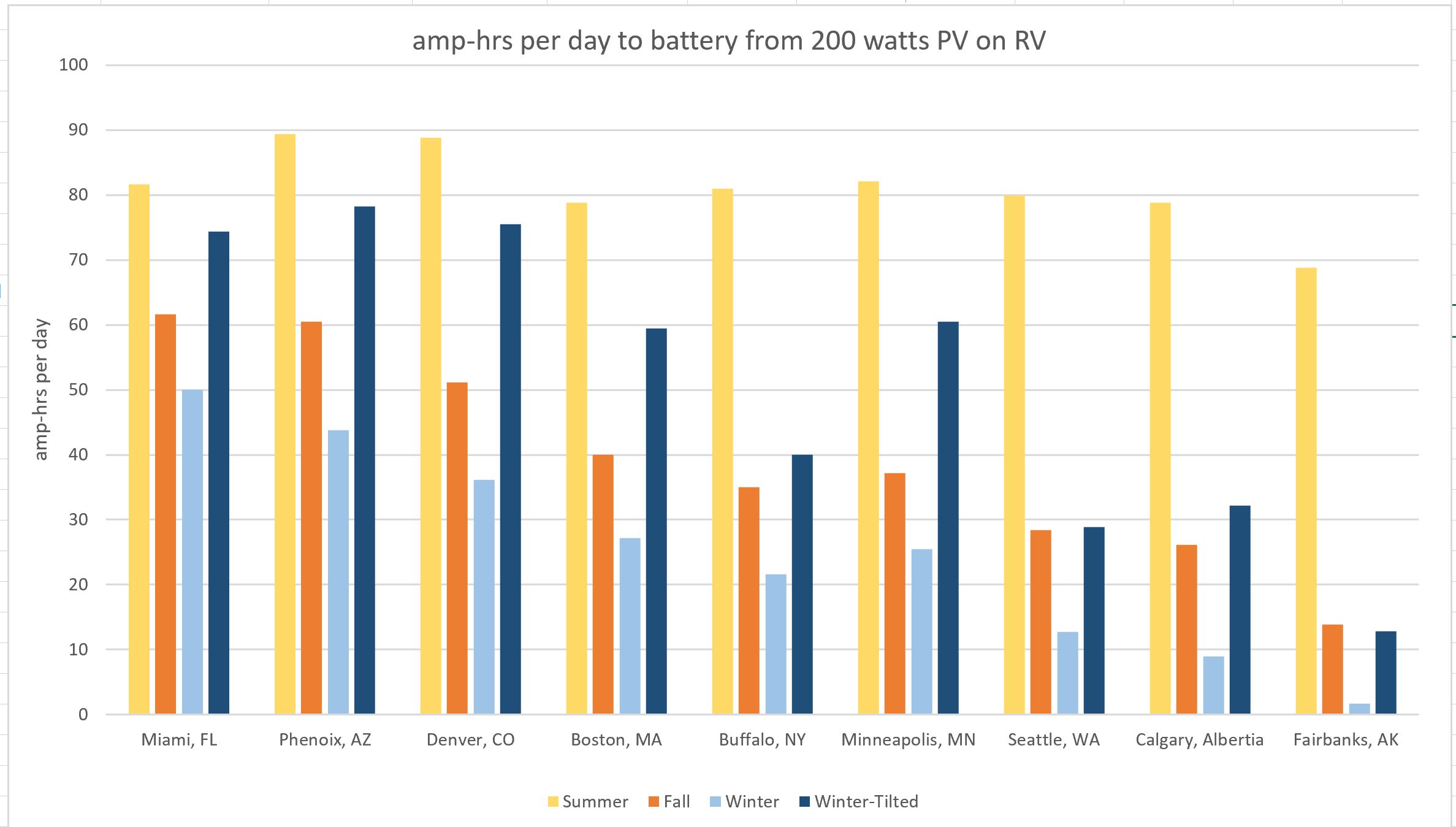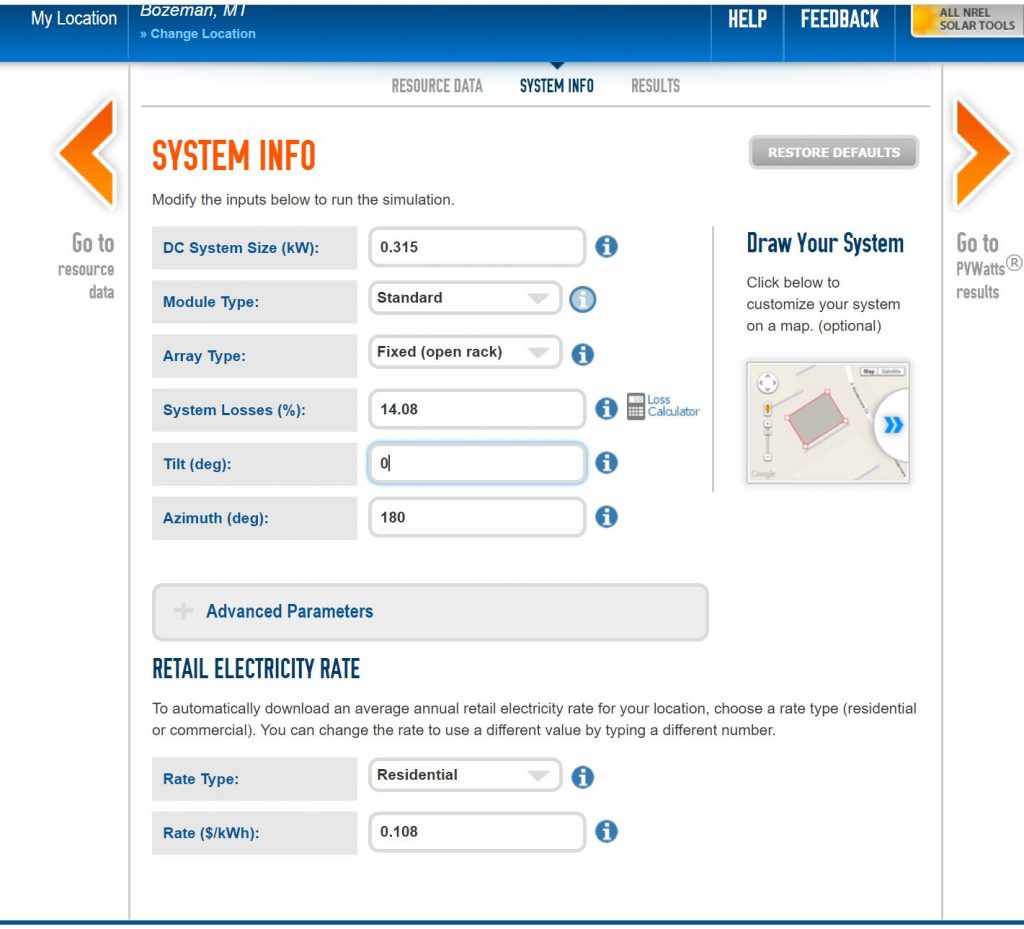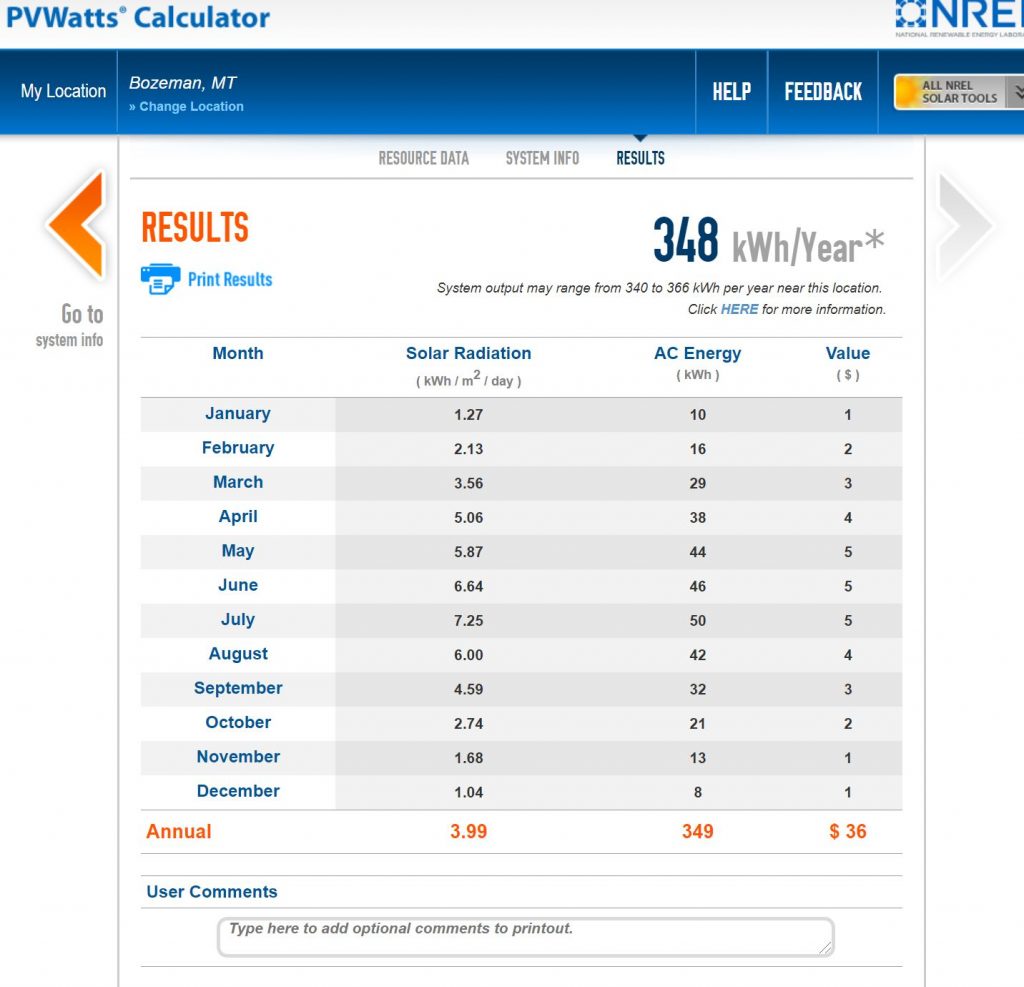The output from the PV panels on your RV will vary quite a bit depending on season of the year and where you are. Summer output is greater than winter output. Lower latitude locations provide generally higher output than high latitude locations — especially in the winter when the days are shorter and sun is lower in the sky at higher latitudes. Chronically cloudy locations provide less solar than sunny ones.
The chart below shows the variations for seven cities spanning the US and Canada — it may be helpful in determining the amount of solar you want to include in your build.
The table provides the number of amp-hrs per day that a 200 watt solar array will generate at each location for summer, fall, and winter — all for horizontal panels. In addition, for winter, it shows output for a panel tilted to latitude plus 15 degrees (ideal winter tilt).
If you have a different size solar array than 200 watts, just ratio up or down accordingly — eg for a 400 watt array, double the numbers in the chart. Or, just run the PVWatts calculator as described below.

In the table:
- The yellow is summer (July) with the solar panel flat (horizontal)
- The orange is fall (October) with the solar panel flat
- The light blue is winter (January) with the solar panel flat
- The dark blue is winter (January) with the solar panel tilted at latitude + 15 degs
I included the tilted panel for winter because tilt makes a lot of difference in output during the winter — especially for more northern locations where the winter sun is low. Tilt does not make much difference for summer or fall. Providing for tilting PV panels for an RV is difficult, but if you use your RV a lot in the winter it may be worth the effort.
All of the points in the table are calculated by running the PVWatts calculator as described below.
Some loose observations…
- The variations from location to location and from season to season are large, so you should consider where you are going to use the RV and in which seasons to arrive a a good estimate of how much solar to include.
- In the summer, solar panels do well pretty much everywhere. Even climates like Seattle, which is known for a lot of cloudy/rainy weather, have sunny summers. And, the sun is high in the sky, which makes the flat panels work well.
- Fall (and Spring) output is fine in southern locations (eg Phoenix), but if you live further north, and want to use your RV for Spring, Summer, Fall, its probably a good idea to install more solar to bring the Spring and Fall output up.
- Winter output in low latitude locations for flat panels runs about half of the summer output. For more northern and/or cloudy locations, winter output goes down to about 1/4 or less of summer output.
- Tilting panels has a dramatic effect on winter output — doubling or even tripling the output in mid winter. This is especially true for northern climates where the sun is low in the winter. But, if you get far enough north (see Fairbanks), not even tilting the panels helps much — days are too short and sun is very low.
PVWatts Example
If you want to look at more cities, other months, … then just run the PVWatts calculator directly — its very straight forward to use. Here is an example…
The PV array on my RV is a single 315 watt panel that is mounted flat on the roof. This example goes through estimating its output for Bozeman, MT.
- Go to the PVWatts website …
On the first page:
- Enter Bozeman, MT for the location, and go on to the next page…
On the inputs page…

- Enter 0.315 KW for DC System Size — where 0.315 KW is 315 watts.
- Enter 0 for Tilt (deg)
- Use the defaults for the rest of the entries unless you have better data.
Go on to results Page:

The Results page shows what the 315 watt, zero tilt panel will produce for each month of the year and for the full year.
One of the output columns is labeled “AC Energy (kwh)” — this gives the KWH output for your PV panels for each month. In this example, 46 KWH are produced in June.
To use the AC Energy column to estimate the average amp-hrs into your battery for each day in June, do the following:
- Calc the KWH per day for June by dividing the 46 KWH output by 30 days => 1.533 KWH per day output
- Convert the 1.533 KWH to watt-hrs by multiplying by 1000 => 1533 watt-hrs per day
- Convert the 1533 watt-hrs to amp-hrs into the battery, divide by 12 volts => 128 amp-hrs per day
This says that on an average June day in Bozeman, the PV panels will put 128 amp-hrs into the house battery. Of course, most days are not average and you will get more or less than the 128 amp-hrs.
About PVWatts
PVWatts is a free solar calculator from NREL. It uses sun and weather data for the location you enter. It takes the most typical year of the past 30 years, and does an hour hour estimate for the full year. It is quite accurate. It also allows you to input the panel tilt you want to use (or even use sun tracking systems). It accounts for typical losses, but allows you to customize the losses for you situation if you like. It can be used for locations anywhere in the world. Your tax dollars at work!
If you want to see even finer (hour by hour) detail, it supports downloading the hour by hour (all 8760 hours) data as a CSV file that that you can read into a spreadsheet to look into the day by day and hour by hour variation of the energy produced by your solar panel.
Caveats:
- PVWatts uses the average weather for the city shown for that month. If you have a few days of worse than average (cloudier) weather, you will get fewer amp-hrs of solar, and vice-versa for sunnier than average weather.
- The table assumes you are using a 12 volt house battery.
